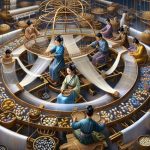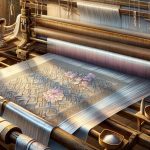Discover the remarkable story of fabric’s indispensable role in shaping our textile history.
From its early innovations to its impact on cultural exchange, fabric has been an integral part of our past.
Explore how fabric has not only served as a symbol of identity but also influenced trade, commerce, fashion, and artistic expression.
Join us on a captivating journey as we uncover the enduring legacy of fabric and its profound significance in our textile heritage.
Table of Contents
Early Fabric Innovations
You can trace the origins of early fabric innovations back to the ingenuity and resourcefulness of ancient civilizations. Silk production, one of the earliest examples of fabric innovation, can be attributed to the ancient Chinese. The Chinese discovered how to cultivate silkworms and extract their silk fibers, which were then spun into luxurious fabrics. This breakthrough not only revolutionized the textile industry but also had a significant impact on trade and cultural exchange.
Another important early fabric innovation was the development of textile printing techniques. Ancient civilizations, such as the Egyptians and the Romans, used various methods to create intricate patterns and designs on fabric. They employed techniques like block printing, where wooden blocks carved with designs were dipped in dye and then pressed onto the fabric. These early printing techniques allowed for the production of unique and visually appealing textiles.
The advancements in silk production and textile printing techniques paved the way for the flourishing of the textile industry. These innovations not only enhanced the quality and variety of fabrics but also played a crucial role in shaping the cultural identities of different civilizations. From the luxurious silk garments of ancient China to the vibrant patterned textiles of Egypt and Rome, early fabric innovations laid the foundation for the rich and diverse world of textiles that we know today.
Fabric’s Influence on Cultural Exchange
The fabric’s influence on cultural exchange can be seen throughout history, as it facilitated the exchange of ideas, styles, and traditions between different civilizations. Fabric has played a crucial role in cultural fusion, allowing societies to borrow from each other and create unique blends of fashion and design. Through trade routes and exploration, fabrics were transported across continents, bringing with them not just physical goods, but also cultural influences.
For example, silk, a highly coveted fabric, was produced in China and then traded along the Silk Road, spreading its influence to various regions. This led to the adoption of silk in clothing and the development of silk-based industries in different parts of the world.
The fabric’s impact on cultural exchange goes beyond just the physical material. It also encompasses the symbolism and meaning associated with certain fabrics. Traditional clothing made from specific fabrics often carries cultural significance and can serve as a way for individuals to express their identity and heritage. The adoption of these fabrics by other cultures can lead to the blending of traditions and the creation of new cultural expressions.
Fabric as a Symbol of Identity
Fabric plays a significant role in preserving cultural heritage. It is often used to represent the traditions and customs of a particular community. Whether it’s the intricate patterns of a traditional costume or the vibrant colors of a tribal textile, fabric serves as a symbol of identity. It connects individuals to their roots and allows them to express their unique heritage.
Fabric and Cultural Heritage
How does fabric play a crucial role in preserving cultural heritage and serving as a symbol of identity?
Fabric is deeply intertwined with traditional crafts and plays a significant role in preserving cultural heritage. Throughout history, different cultures have developed unique weaving techniques and patterns, creating fabrics that are distinct to their identity. These fabrics not only showcase the skill and artistry of the craftsmen but also tell the story of a particular culture and its traditions.
Moreover, fabric is often used in religious ceremonies, symbolizing the beliefs and values of a community. From the intricate textiles used in Hindu rituals to the sacred garments worn by priests in various religions, fabric serves as a powerful symbol of cultural heritage and identity, connecting people to their roots and preserving traditions for future generations to appreciate.
Fabric and Self-Expression
Express yourself with fabric as a symbol of your unique identity, using the wide range of options available to showcase your personal style. Fabric plays a significant role in self-expression, allowing individuals to convey their personality and individuality through the clothes they wear.
The choice of fabric can reflect one’s personal style, whether it be bold and vibrant prints or subtle and understated textures. Moreover, fabric can also be used as a symbol of social status. Historically, certain fabrics were reserved for the elite, showcasing wealth and prestige.
Today, fabric choices can still communicate social standing, with luxury fabrics like silk and cashmere being associated with affluence. By carefully selecting the fabrics you wear, you have the power to express your unique identity and make a statement about your personal style and social status.
Fabric’s Impact on Trade and Commerce
By weaving its way into the global marketplace, fabric has played a pivotal role in shaping trade and commerce. Its economic impact and role in global trade can’t be underestimated. Here are four ways fabric has influenced the world of trade and commerce:
-
Textile exports:
Fabric production has been a significant source of revenue for many countries. Textile exports have created jobs and stimulated economic growth. Countries like China, India, and Bangladesh have become major players in the global textile market, exporting fabrics to various parts of the world. -
Global supply chains:
Fabric is an essential component of many products, such as clothing, furniture, and automotive interiors. The demand for fabric has led to the development of intricate global supply chains, connecting manufacturers, suppliers, and retailers across continents. This interconnectivity has boosted international trade and accelerated economic activity. -
Fashion industry:
The fashion industry heavily relies on fabric, driving trends and consumer demands. Fabric innovations and new textile technologies have revolutionized the fashion industry, creating new opportunities for designers and entrepreneurs. From haute couture to fast fashion, fabric plays a central role in shaping the global fashion market. -
Trade agreements:
Fabric has also been a focal point in international trade agreements. Tariffs, quotas, and rules of origin have been established to regulate the import and export of fabrics. These agreements aim to protect domestic industries, promote fair trade practices, and ensure that fabric-based products meet certain standards.
The Evolution of Fabric in Fashion
As a fashion enthusiast, you may be fascinated by the evolution of fabric in the industry. One of the most significant developments in recent years is the increasing focus on sustainability in fabric production. As consumers become more conscious of the environmental impact of the fashion industry, designers and manufacturers are exploring new ways to create fabrics that are eco-friendly and ethically produced. This has led to the rise of sustainable materials such as organic cotton, recycled polyester, and hemp, which are being used to create beautiful and durable garments.
In addition to sustainability, the future of fabric technology holds great promise for the fashion industry. Researchers and scientists are constantly pushing the boundaries of what’s possible, experimenting with new materials and techniques. For example, there are ongoing developments in smart textiles, which have the ability to change color, regulate temperature, and even monitor health indicators. These innovations have the potential to revolutionize the way we think about and interact with clothing.
As a fashion enthusiast, it’s exciting to see how fabric is evolving in the industry. With a growing emphasis on sustainability and the continuous advancements in fabric technology, the future of fashion looks promising. By embracing these changes and supporting brands that prioritize eco-friendly practices, we can contribute to a more sustainable and innovative fashion industry.
Fabric’s Role in Artistic Expression
Fabric serves as a canvas for artistic expression, allowing artists to transform it into unique works of art.
The texture of fabric enhances the creativity of artists, adding depth and dimension to their creations.
Additionally, the use of different colors in fabric evokes various emotions, enabling artists to convey their intended message through their artwork.
Fabric as Canvas
Express your creativity and bring artistic visions to life by using fabric as a canvas for your imagination. Fabric has long been recognized as an essential medium for artistic expression, allowing artists to explore various techniques and create stunning works of art.
Here are four ways fabric can be used as a canvas:
-
Painting: Fabric can be treated as a traditional canvas, allowing artists to use different types of paints and dyes to create unique and vibrant designs.
-
Embroidery: Fabric provides a textured surface for intricate embroidery work, adding depth and dimension to artistic creations.
-
Collage: By layering different fabrics and materials, artists can create visually striking collages that tell a story or convey a specific message.
-
Fabric in interior design: Fabric can be used to transform interior spaces, whether it’s through curtains, upholstery, or wall hangings, adding color, texture, and personality to a room.
Incorporating fabric into your artistic endeavors opens up a world of possibilities, allowing you to explore and push the boundaries of your creativity.
Texture Enhancing Creativity
Enhance your creativity by exploring the role of fabric in artistic expression through its texture.
Fabric has the power to stimulate your creativity and elevate your artistic endeavors to new heights. The texture of fabric adds depth and dimension to your artwork, allowing you to create visually captivating pieces.
As you work with different fabrics, you’ll discover the unique sensory experience they offer. The touch and feel of the fabric can inspire new ideas and bring a sense of joy and excitement to your creative process.
Whether you’re painting on fabric, sculpting with textiles, or using fabric as a medium for mixed media art, the texture of the fabric will enhance the overall aesthetic of your work and provide endless possibilities for artistic expression.
Colors Evoking Emotions
As you explore the role of fabric in artistic expression through its texture, you’ll discover how colors evoke emotions and play an integral role in bringing your artwork to life. Color psychology is the study of how colors can impact human emotions and behaviors. When it comes to fabric and interior design, the choice of colors becomes crucial.
Here are four ways in which colors evoke emotions and enhance artistic expression:
- Warm colors like red, orange, and yellow can evoke feelings of energy, passion, and happiness.
- Cool colors such as blue, green, and purple can create a sense of calmness, tranquility, and relaxation.
- Neutral colors like white, gray, and beige can provide a sense of balance and simplicity.
- Bold and vibrant colors can make a statement and evoke strong emotions.
Fabric’s Enduring Legacy in Textile History
Fabric has played a pivotal role throughout textile history, leaving behind a lasting legacy. From the earliest civilizations to the present day, fabric has been an integral part of human existence. Ancient civilizations recognized the importance of fabric and its connection to their cultures. The Egyptians, for example, used linen to create clothing and burial shrouds, symbolizing both wealth and spirituality. In ancient Greece, fabric was used not only for clothing but also for theatrical costumes, expressing the characters’ identities and emotions.
Fabric’s legacy extends beyond its cultural significance. It has also played a crucial role in technological advancements. The invention of the spinning wheel and the loom revolutionized the textile industry, making fabric production faster and more efficient. This led to the development of new fabric types, such as silk and cotton, and the expansion of trade routes to satisfy the growing demand for textiles.
In modern times, fabric continues to shape our world. It’s used in industries ranging from fashion and interior design to medical and aerospace. Innovations like synthetic fabrics and 3D printing have pushed the boundaries of what fabric can achieve. Fabric’s endurance throughout history is a testament to its versatility and importance. It will undoubtedly continue to leave its mark on textile history for generations to come.
Frequently Asked Questions
What Are the Earliest Known Fabric Innovations in Textile History?
You’ll find fascinating early techniques and textile artifacts in the history of fabric innovation. From ancient looms to hand-spun fibers, these innovations laid the foundation for the integral role fabric plays in our textile past.
How Did Fabric Influence Cultural Exchange Between Different Regions and Civilizations?
Fabric’s integral role in textile history influenced cultural exchange between regions and civilizations. Through trade, fabric became a medium for sharing ideas, styles, and techniques, leading to the blending of diverse cultures and the development of new textile traditions.
Is Fabric Solely Seen as a Symbol of Identity in Clothing or Does It Have Other Cultural Implications?
Fabric isn’t just about clothing and identity. It plays a vital role in religious ceremonies, adding a sense of reverence and spirituality. Additionally, fabric’s symbolism in art and literature adds depth and meaning to cultural expressions.
How Did Fabric Impact Trade and Commerce in Ancient Civilizations?
Fabric played a significant role in ancient civilizations’ trade and commerce. Its impact on the economy and role in globalization cannot be overlooked. You’ll be surprised at how fabric shaped the world.
What Are Some Significant Milestones in the Evolution of Fabric in the Fashion Industry?
The evolution of fabric technology has had a significant impact on fashion trends. Over time, advancements in fabric production and design have allowed for the creation of new materials and styles, revolutionizing the fashion industry.
- The Best Temperature to Wash Cotton Polyester Clothing - June 23, 2025
- Can You Use Sublimation on a 50/50 Cotton Polyester Blend? - June 23, 2025
- How to Make Your Cotton Polyester Garments Last Longer - June 23, 2025





